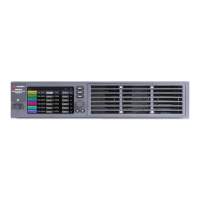Instrument Calibration
Introduction
Calibration Interval
Calibration Setups
Test Considerations
Voltage Programming and Measurement Calibration
Current Programming and Measurement Calibration
Enter a Calibration Date
Save Calibration and Exit
Introduction
The instrument features closed-case electronic calibration; no internal mechanical adjustments are
required. The instrument calculates correction factors based on input reference values that you set
and stores correction factors in non-volatile memory until the next calibration adjustment is
performed. This EEPROM calibration memory is not changed by cycling power or *RST.
Refer to the Test Equipment and Setups section for a list of the equipment and test setups required for
calibration. Also refer to the Measurement Setups section for information about connecting the
voltmeter, current shunt, and load. Additional information about calibration follows.
l
The correct password is required to enter the calibration function. The password is pre-set to 0
(zero). You can change the password once calibration mode is entered to prevent unauthorized
access to the calibration mode. Refer to Password Protection for more information.
l
When calibrating the unit using SCPI commands, most steps involve sending a *OPC? query to syn-
chronize with the power supply’s command completion before proceeding. The response from the
instrument must be read each time *OPC? is given. In some steps, it may take up to 30 seconds for
*OPC? to respond.
l
Once started, you must complete each calibration section in its entirety. As each calibration sec-
tion is completed, the instrument calculates new calibration constants and begins using them.
These constants are not saved in nonvolatile memory until a SAVE command is explicitly given.
l
Exit the calibration mode by sending CAL:STAT OFF. Note that any calibration section that was cal-
ibrated but not saved will revert to its previous calibration constants.
Keysight MP4300 Series Operating and Service Guide 175
6 Verification and Calibration

